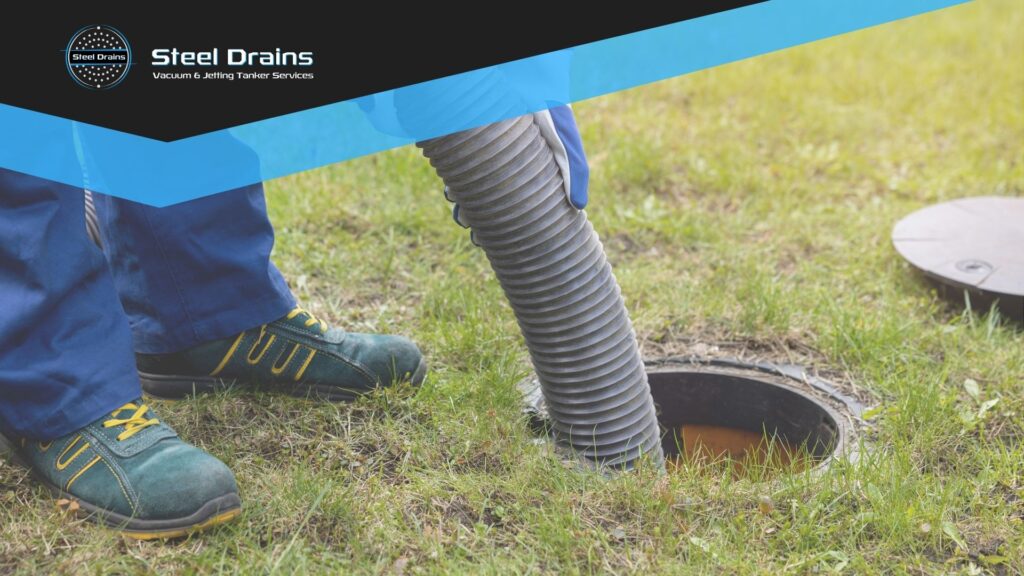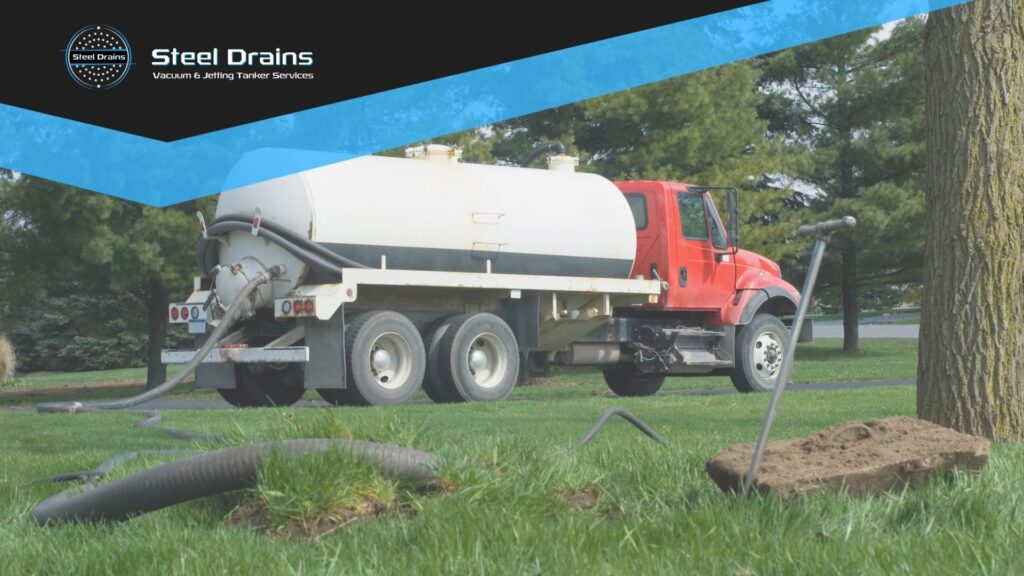Introduction
A septic tank is an essential component of wastewater management, particularly in rural areas of the UK where properties are not connected to the mains sewer system. These underground chambers are designed to treat and dispose of household sewage, ensuring that waste is safely broken down and filtered before it re-enters the environment. However, the effective functioning of a septic tank relies heavily on regular maintenance and timely emptying. Ignoring these crucial aspects can lead to costly repairs, environmental hazards, and health risks.
Recognising the signs of septic issues is vital for any homeowner or property manager reliant on a septic system. This blog post will explore the key signs that indicate your septic tank needs urgent emptying, helping you to maintain a healthy living environment and avoid significant problems.

Understanding Your Septic Tank System
Components of a Septic Tank System
A septic tank system comprises several key components that work together to treat wastewater effectively. These include the septic tank itself, the drain field, and the soil that surrounds them.
- Septic Tank: The primary component, this large, buried tank is designed to hold wastewater long enough for solids to settle at the bottom, forming sludge, while fats, oils, and grease float to the top, creating scum. The clarified liquid effluent then flows out into the drain field.
- Drain Field: Also known as a leach field, this is a series of perforated pipes laid in trenches beneath the ground. It allows the treated effluent to percolate through the soil, where it is further filtered and cleansed before entering the groundwater.
- Soil: The surrounding soil plays a critical role in treating the effluent. It acts as a natural filter that removes harmful pathogens and nutrients, ensuring that only clean water re-enters the environment.
Biological Processes in a Septic Tank
The septic tank relies on a combination of physical and biological processes to treat wastewater. The breakdown of solids is largely facilitated by anaerobic bacteria that thrive in the low-oxygen environment of the tank. These bacteria consume the organic matter in the sludge, reducing its volume and helping to maintain the efficiency of the system.
However, the success of this biological treatment process depends on several factors, including the tank’s size, the volume of wastewater produced, and the regularity of maintenance. Neglecting to empty the septic tank can disrupt these processes, leading to system failure and potential health hazards.
Key Signs Your Septic Tank Needs Urgent Emptying
1. Slow Drains and Toilets
One of the most common signs that your septic tank needs urgent emptying is slow drainage in sinks, baths, and toilets. This can manifest as water pooling in the sink or toilet bowl, taking longer than usual to drain away.
When the septic tank becomes full, the flow of wastewater is impeded, causing it to back up into the household plumbing. This blockage can stem from accumulated sludge and scum, which reduces the tank’s capacity to handle incoming waste. If you notice slow drains, it’s essential to investigate further, as this could indicate a full or clogged septic tank.
2. Unpleasant Odours
Another clear indication of septic issues is the presence of unpleasant odours around the tank or drain field. If you detect strong sewage smells, this could signal that your septic tank is full or that there is a leak in the system.
These odours can arise from gases produced by the decomposition of organic matter within the tank. When the tank is full, these gases may escape through the venting system or even bubble up through the ground if there is a leak in the tank. It’s crucial to address these smells promptly, as they can signal not only a full tank but also potential health risks from untreated sewage.
3. Pooling Water or Wet Spots
Pooling water or soggy areas near the drain field can indicate a failing septic system or an overflowing tank. If you notice unusually wet spots in your yard, especially during dry weather, this could suggest that effluent is surfacing instead of being properly absorbed by the soil.
Leaving this issue unaddressed can lead to more severe problems, including contamination of groundwater and damage to the drain field itself. The presence of standing water can also attract pests and create an unsightly environment.
4. Gurgling Sounds
Gurgling noises in plumbing fixtures can be another alarming sign of septic issues. If you hear gurgling sounds when you flush the toilet or run the sink, this could indicate trapped air due to blockages within the septic system.
These sounds occur when wastewater struggles to flow through the pipes, often because the tank is full or there is a blockage in the drain field. If you experience gurgling sounds, it’s essential to have your septic tank inspected and emptied as soon as possible to prevent further complications.
5. Backed-Up Drains
Backed-up drains and toilets are a direct indicator that your septic tank is full and requires immediate attention. If you find that wastewater is backing up into your home, this is not only inconvenient but poses significant health risks associated with untreated sewage.
When the septic tank is full, it can no longer effectively process incoming waste, leading to sewage spilling back into the home. This situation can cause damage to your property and pose serious health risks to your family. Immediate action, such as contacting a professional for septic tank emptying, is crucial.
6. Lush Vegetation Over the Drain Field
Unusually lush grass or plant growth over the drain field can indicate a septic tank issue, particularly if there are no other explanations, such as regular watering or fertilising. While healthy vegetation is generally a good sign, excessive growth may suggest that the drain field is saturated with effluent.
This saturation can lead to reduced efficiency in wastewater treatment, as the soil becomes overwhelmed and can no longer filter the effluent effectively. Regular checks on the health of your drain field can help identify and rectify issues before they escalate.
7. Frequent Pumping Needed
If your septic tank requires emptying more often than every three to five years, this may indicate a problem with the tank or changes in usage patterns. Several factors can affect the frequency of septic tank pumping, including household size and water usage habits.
For instance, if you have recently increased the number of occupants in your home or have started using more water-intensive appliances, the tank may fill up more quickly than anticipated. If frequent pumping is needed, it’s essential to evaluate your water usage and consult a professional to determine if there are underlying issues with your septic system.
The Importance of Regular Septic Tank Maintenance
Regular septic system maintenance is crucial in preventing emergencies and ensuring the long-term efficiency of your system. By scheduling routine inspections and maintenance, homeowners can identify potential issues before they escalate into costly repairs.
Septic tank maintenance typically involves:
- Regular Pumping: Emptying the tank every three to five years, depending on usage, can prevent sludge buildup and ensure that the system operates efficiently.
- Inspections: Routine inspections can help identify signs of wear and tear, leaks, or blockages that may require attention.
- Monitoring Water Usage: Being mindful of water usage can help reduce the frequency of pumping and extend the lifespan of the septic system.
Investing in regular maintenance not only helps prevent emergencies but also contributes to the longevity of your septic tank, protecting your property and the environment.
When to Seek Professional Help
There are specific circumstances when homeowners should contact a professional for septic tank services. These include:
- Signs of Septic Issues: If you observe any of the signs discussed above, such as slow drains, unpleasant odours, or backed-up drains, it’s crucial to seek professional assistance immediately.
- Unusual Changes in Usage: If you notice significant changes in water usage patterns or household occupancy, it’s a good idea to consult a professional to assess the capacity of your septic system.
- Regular Maintenance Needs: If you’re unsure about your system’s maintenance schedule or how to perform routine checks, hiring a qualified septic service provider can help you stay on track.
Hiring qualified professionals ensures that any work done on your septic system is completed to the highest standard, reducing the risk of further complications and ensuring compliance with local regulations.
The Consequences of Neglecting Your Septic Tank
Neglecting to address signs that your septic tank needs emptying can lead to severe repercussions. These may include:
- Health Hazards: Untreated wastewater can pose significant health risks, including exposure to harmful bacteria and viruses. This is particularly concerning for families with children or vulnerable individuals.
- Costly Repairs: Ignoring septic issues can lead to system failure, resulting in expensive repairs or even the need for a complete replacement of the septic system.
- Environmental Concerns: Septic system failures can lead to contamination of groundwater and local waterways, posing risks to public health and the environment.
- Legal Implications: In the UK, homeowners can face legal consequences for failing to maintain their septic systems, particularly if they cause environmental harm. Local regulations often require proper maintenance and reporting of septic system issues.
Regularly monitoring your septic system’s health and addressing any signs of issues promptly is essential for protecting your home, health, and the environment.

Conclusion
In summary, being aware of the signs that your septic tank needs urgent emptying is crucial for maintaining a healthy home and environment. Slow drains, unpleasant odours, pooling water, gurgling sounds, backed-up drains, lush vegetation, and frequent pumping requirements are all indicators that your septic system may be in distress.
Regular maintenance and prompt attention to these signs can help prevent costly repairs and health hazards associated with septic system failures. As a UK homeowner or property manager reliant on a septic tank, it’s imperative to monitor your system closely and seek professional help when necessary.
Don’t wait for a minor issue to escalate into a significant problem—stay proactive and ensure the longevity and efficiency of your septic system!